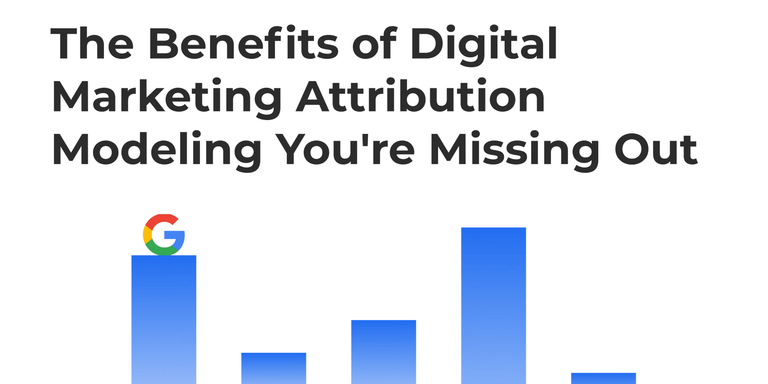Maybe it wasn’t the right decision to turn off that high traffic Google Ads campaign because of no conversions? Those visitors might get back to your website a few times more and eventually buy your stuff.
Maybe it’s just you didn’t know it?
So if you want to measure the real effectiveness of your marketing dollars spent, keep on reading. We’ll break down what is data driven marketing attribution modeling, what model types are available, and which one might work for you.
What is marketing attribution modeling?
Marketing attribution modeling is an organized set of rules that attribute credits for different touchpoints across the customer journey.
In other words, a way for you to measure the real impact of your marketing activities.
Why you’re putting yourself at risk by not having marketing attribution modeling in place
Some paid marketers I know are obsessed with optimizing their campaigns for higher CTR and lower CPC. Those who look a bit further are optimizing for conversions instead, which seems logical. But conversions don’t always impact main targets in the way you think.
But before beginning, do you know what is marketing attribution?
Not all customers have equal LTV, and not all campaigns are converting from the first touchpoint. I would even say, not every touchpoint is designed to convert. But you still need to measure its effectiveness. For B2B, these rules are especially true.
So you can continue optimizing your Facebook ad campaign for the best-in-class CTR or conversion rate. For sure, it may bring you hundreds of dollars plus. But on the scale of a business, you might be doing a tiny thing that doesn’t make a difference at all.
Your company’s success is your success. So you should optimize marketing towards the primary company goal – revenue. And if you’ve never thought this way, you definitely should start.
Examples of marketing attribution modeling
Imagine you have a customer journey with a Google ad as the first touchpoint. By clicking the ad, people start engaging with your brand on social, webinars, whatever. And eventually, after a month or so, they type in your website address and buy your product.
Most likely, you’ll attribute revenue to direct or organic traffic and forget about what happened during this journey.
But it’s like getting your salary and saying it was not essential to do the job to get it.
So you can end up turning off a campaign that brings you customers just because it has a low conversion rate. But it can drive awareness like crazy. The thing is nobody cares.
During our project with Betty Bossi, there were multiple channels and even website pages tracked as a part of the customer journey. So each touchpoint was considered. And one essential and surprising insight was gained from the analysis. The Google Ads branding campaigns turned out to be invaluable in attracting customers who then return over organic channels. This was not visible using the standard, simplistic last-click attribution models.
Think about it.

Is marketing attribution modeling only for paid channels?
No, it is not.
With marketing attribution modeling tools, you can pull the data from your ad accounts, social media accounts, email provider, website, programmatic ad network, influencer marketing campaigns, etc. It even works with offline channels and TV advertising – it is called “Mix Modeling.”
It’s all about getting a full picture of your customer journeys and giving credits to marketing activities that deserve it.
Why Google Analytics is not always the answer
Many marketers use Google Analytics as a hub of their cross-channel marketing data. Google has some common attribution models to help you measure the performance of your marketing channel. But with adding more channels, like programmatic advertising, it becomes painful to measure the impact.
Sometimes, it makes much more sense to have all costs and conversions easily accessible in a dashboard and different attribution models compared on the same screen.
This way, you have much clearer and actionable data, save time, and even headcount. Of course, if you do it right.
How to choose the right attribution model for your marketing
To get all the benefits of marketing attribution modeling, you need to understand your goals and have a firm grip on the customer journey. Below you’ll find 11 attribution models with our recommendations on when to use and to avoid each of them.
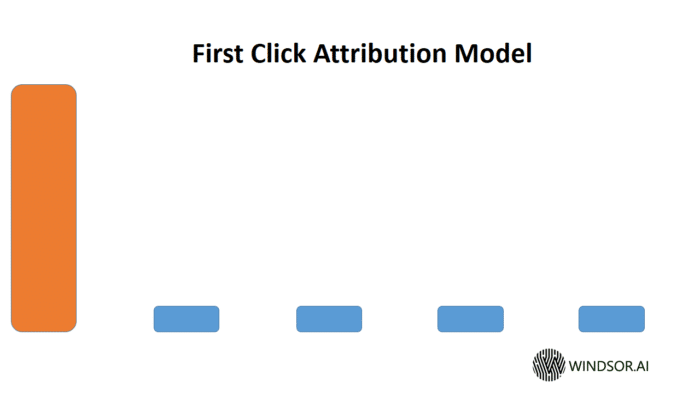
1. First Click Attribution Model
The first click attribution model works on a simple formula. It attributes a conversion to the source that referred a buyer to your website for the first time.
Example:
A prospective visitor sees your Google ad and lands on your website for the first time. They might browse around, signup to your email newsletter, follow your Facebook page, and leave.
After a few days, they come back and purchases your product.
Despite no immediate purchase and interactions with other channels, the credit goes to the Google ad as it was the first touch of your brand with the client.
Use first click attribution model:
- To identify channels that bring in the most leads or customers.
- To determine the best channel for creating awareness of your brand.
- If you have minimal marketing channels (i.e., focusing only on Facebook and Google Ads).
Avoid first click attribution model:
- If you have multiple marketing channels and a sophisticated customer journey. This model gives no value to other touchpoints.
- If your customer buying cycle is longer than 30 to 90 days. Google Analytics cookies expire within that period, and you can lose the data.
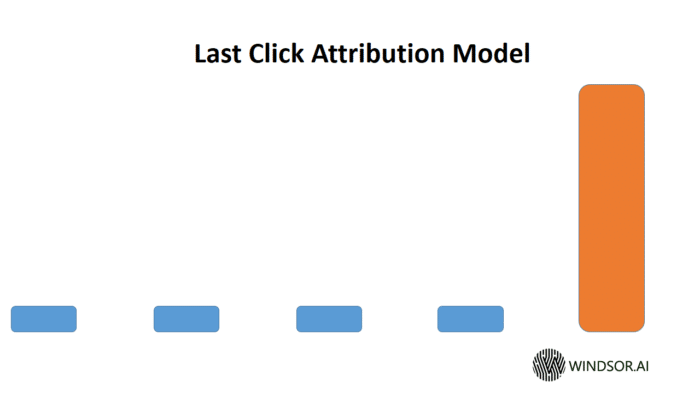
2. Last Click Attribution Model
The last click model completely brushes aside the value the website has in getting paying customers. Thus, a company relying on this model will be overvaluing one marketing channel while dramatically undervaluing another marketing channel.
In the last click attribution model, all credit goes to the marketing touchpoint that resulted in conversion.
Example:
You knew Apple for years from their ads and word of mouth. But you bought a new Mac during the Black Friday sale. According to last click attribution, the Black Friday campaign gets all the credits for the conversion.
Use last click attribution model:
- To understand high-impact touchpoints at the bottom of your funnel. It helps you find channels that are driving the most conversions.
Avoid last click attribution model:
- If you have a complicated customer journey that requires research before making a buying decision. With this model, you neglect other critical touchpoints and limit your understanding of marketing performance.
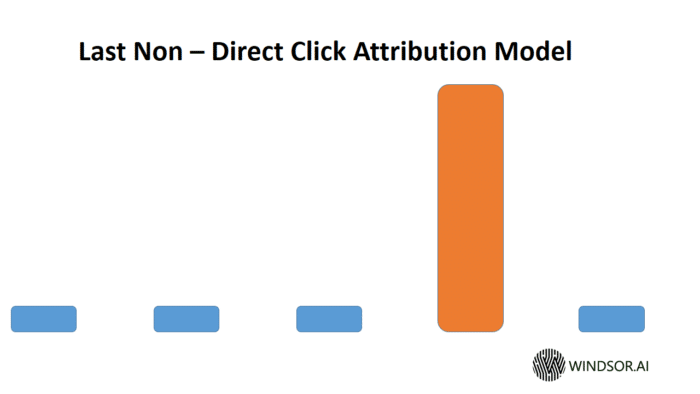
3. Last Non-Direct Click Attribution Model
In this attribution model, the significance is given only to the last non-direct marketing channel.
Google Analytics considers as Direct traffic when a user types in your website address into a search bar. Any traffic that has no referral folds into this bucket as well.
Example:
In other words, it’s like saying that the user who typed in yourwebsite.com into search and purchased your product, made the decision beforehand. So you’re giving all the credits to the touchpoint that came before the direct visit resulted in conversion.
Use last non-direct click attribution model:
- To understand the effectiveness of your marketing tactics, without accounting for the direct traffic.
Avoid last non-direct click attribution model:
- If you have offline campaigns that lead a user to the website to convert. In this case, “direct” could be the only touchpoint with your brand online.
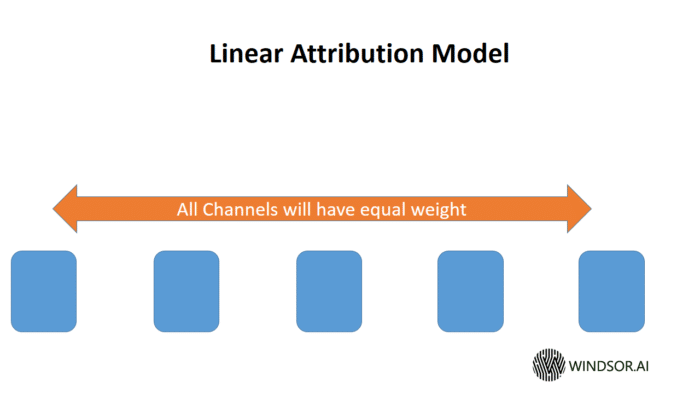
4. Linear Attribution Model
The linear attribution model gives the same credit to every channel across the whole customer journey from the first interaction to making a purchase.
Example:
- Someone sees your ad on Facebook and clicks it to visit the website. (33.3%)
- A person comes back later, directly typing your website address to get more info and compare your products with the competition. (33.3%)
- A few days later, they click on your retargeting ad and buy. (33.3%)
According to the linear attribution model, you’ll have 33.3% attributed to each of the touchpoints.
Important note: If the user directly visited your website 6 times, 75% of the value will go to direct traffic. So remember, EVERY touchpoint is credited.
Use linear attribution model:
- To understand and find channels that result in brand awareness and conversion.
- To identify channels that are consistent across all customer journeys, especially the ones driving actual conversions.
Avoid linear attribution model:
- If you already have a decent understanding of your customer journey and need to identify critical touchpoints. Equal value to each touchpoint is not what you’re looking for in this case.
- You have a journey where most of the decision making happens within a particular touchpoint like having a 1-to-1 workshop alongside social media. The magic happens during a conversation.
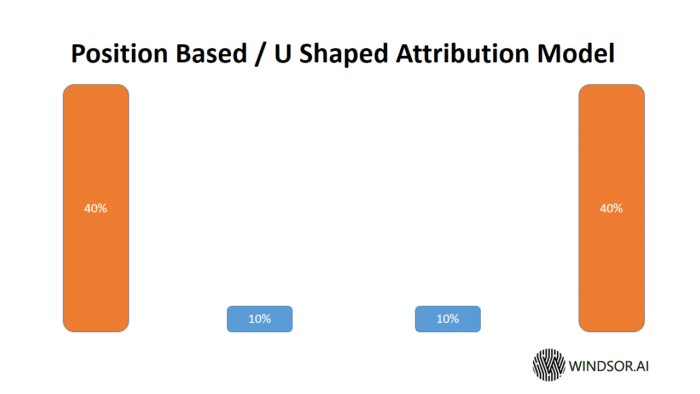
5. Position-Based Attribution Model (U-shaped Attribution Model)
The position-based or U-shaped attribution model gives a certain percentage to all the touchpoints contributing towards conversion.
The first and last touchpoints get 40% of the credit each, and the rest of the touchpoints divide the remaining 20%.
Example:
- Some guy decides to purchase an insurance policy online and starts researching it on Google. He lands your website from the SERP. (40%)
- He finds you on Facebook and clicks on the article from the feed. (10%)
- In a few days, he comes back to your website directly to read a few more articles and leaves an email for a brochure. (10%)
- He eventually converts after seeing your Facebook retargeting ad. (40%)
In that case, organic search and a Facebook ad will get the 40% of credit each, while the rest of the touchpoints will share the remaining 20% among them.
Use position-based attribution model:
- To understand which channel is best for acquiring an audience and which one is excellent for conversions.
- If you have the buying cycle within the expiration of the GA cookies (30 to 90 days).
Avoid position-based attribution model:
- If you heavily rely on nurturing campaigns.
- If you have a long decision-making cycle. You can lose first touch data due to cookie expiration and end up acting on misleading data.
- If you’re in the e-commerce business and have many seasonal campaigns. In this case, the first touchpoint will most likely get too much credit assigned compared to the influence it made.
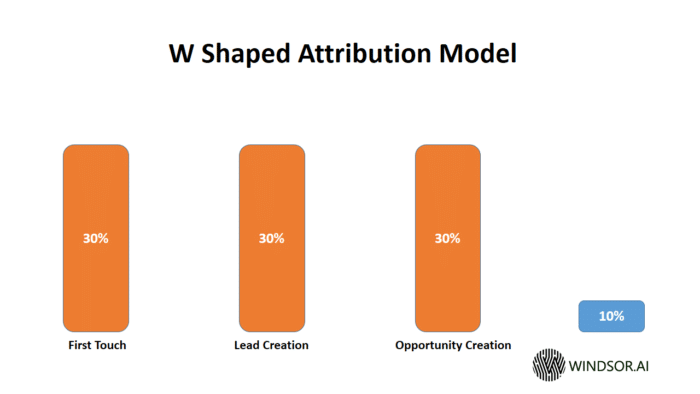
6. W-Shaped Attribution Model
In the W-shaped attribution model, 90% of the credit is equally divided among the three touchpoints:
- First Touch
- Lead Creation
- Conversion
And the remaining 10% is distributed among other channels within the journey.
The W shaped attribution model is an enhanced version of the position-based or U-shaped attribution model.
Example:
Let’s take the U-shaped case above. 90% would be divided among steps 1, 3, and 4. And the rest will go to step 2.
- Some guy decides to purchase an insurance policy online and starts researching it on Google. He lands your website from the SERP. (30%)
- He finds you on Facebook and clicks on the article from the feed. (10%)
- In a few days, he comes back to your website directly to read a few more articles and leaves an email for a brochure. (30%)
- He eventually converts after seeing your Facebook retargeting ad. (30%)
Use W-shaped attribution model:
- For identifying the touchpoints that result in an action. It removes focus from additional channels and helps you identify your audience builder, lead generator, and conversion creator channels.
- You’re in B2B marketing with clear funnel stages your customers go through.
Avoid W-shaped attribution model:
- If you’re in B2C marketing with short sales cycles and user journeys, not necessarily including a lead generation step.
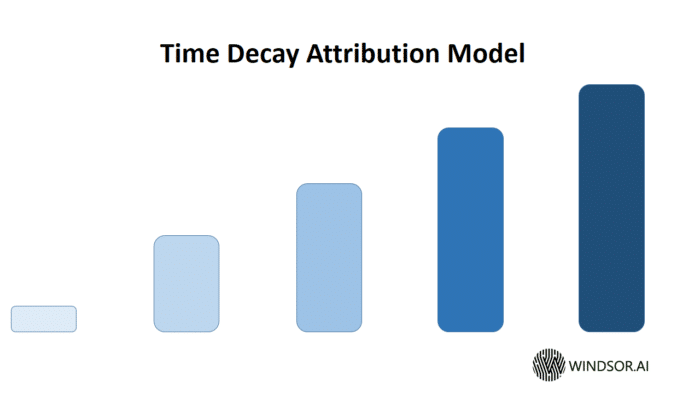
7. Time Decay Attribution Model
In this attribution model, the preference goes to the channels that are closer to the conversion point.
Example:
You’re going to the kitchen from the living room. With the time decay attribution model, your first steps would be much less valuable than the last few before entering the kitchen.
The same applies to marketing touchpoints. The first website visit has the least value, while the touchpoint that led to the conversion will be the most important one.
Use time decay attribution model:
- To understand which channels are assisting and driving conversions in B2C space or B2B with short customer journeys.
Avoid time decay attribution model:
- If you’re focusing on driving awareness.
- If you have long B2B sales cycles where the decision is usually made before the last touchpoint, which becomes a formality.
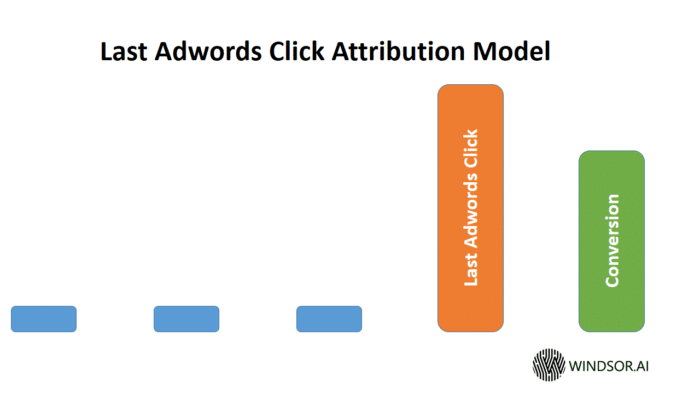
8. Last Google Ads {any other platforms} Click Attribution Model
This attribution model focuses only on the performance of Google Ads campaigns. This model gives all credit to the last Google Ads campaign on a journey or a Google ad that directly led to a conversion.
The same applies to other channels like Facebook, Twitter, LinkedIn, etc. But be careful with this attribution model for evaluating multiple channels. If you have Google Ads and Facebook Ads within one journey, each of them will attribute conversion (the same one) to their channel. This means you’ll meet a problem of duplicated conversions and having misleading data in your reports.
Use last Google Ads click attribution model:
- To determine which ad campaign is driving the best results for your business.
- To identify top Google ad keywords driving the conversions.
Avoid last Google Ads click attribution model:
- If you have a complicated customer journey with valuable touchpoints within.
- If you want to evaluate the performance of multiple paid channels at a time.
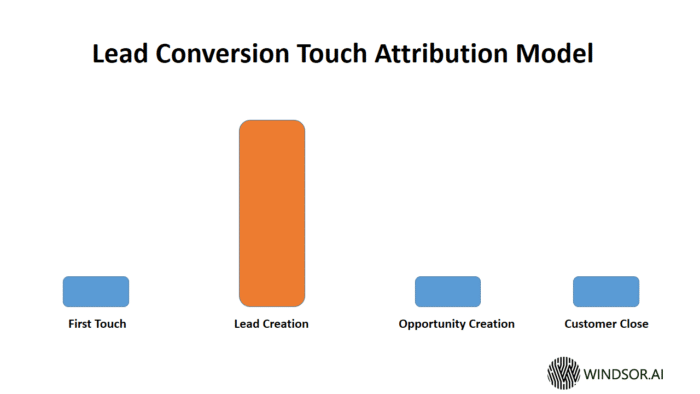
9. Lead Conversion Touch Attribution Model
The lead conversion touch attribution model gives all the credit to the channel through which the lead was generated.
Example:
It is widely applicable for a B2B scenario when a visitor becomes a lead but doesn’t convert into a customer.
Let’s say you landed in this article and found out the benefits of attribution modeling. You didn’t become a paying customer right away but were eager to learn more and signed up for a trial.
At this stage, you become a lead, and if you convert into a customer, all the credits will go to the channel resulting in a free trial.
A great scenario, isn’t it?
Use Lead Conversion Touch Attribution:
- If you need to identify touchpoints or channels that are driving leads.
Avoid Lead Conversion Touch Attribution:
- If you have a long nurturing process with multiple activities. However, if your nurturing funnel works nice and all you need is to bring more leads to the pipeline, the lead conversion touch model is a nice place to go.
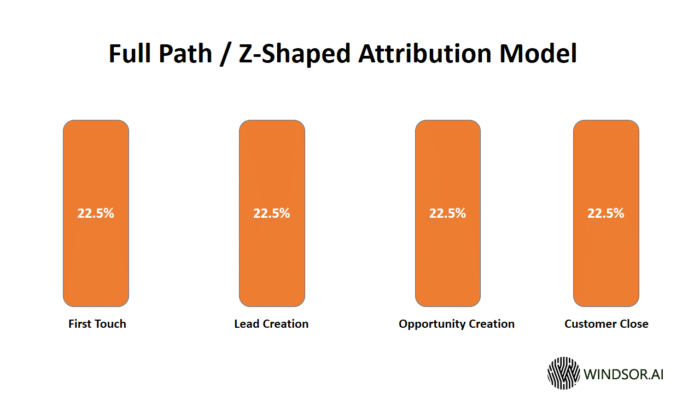
10. Full-Path (Z-Shaped)
In the full-path ( Z-shaped) attribution model, 90% of the credit is equally divided among the four primary channels:
- The First touch (22.5%)
- Lead Generation (22.5%)
- Opportunity Creation (22.5%)
- Customer Close (22.5%)
While the remaining 10% is shared among the rest of the channels.
Example:
You are the owner of an online training course website.
First touch: Someone Googles for a training course and lands on your website to find your available courses.
Lead generation: After a few days, they come back again and downloads an E-book on how to learn efficiently.
Opportunity Creation: You email them and offer a free class for their preferred courses. The person accepts it.
Customer Close: After the free class, you send them an email with a 20% discount on that course. The person buys it and becomes your customer.
In this scenario, the full-path attribution model will give equal credit (22.5%) to all channels that resulted in action till customer closing. The remaining 10% goes to all other channels within the journey.
Use full-path (Z-shaped):
- To evaluate which marketing channels are driving actions towards closing a deal.
- If you have a comprehensive customer journey and strong alignment between marketing and sales teams.
Avoid mull-path (Z-shaped):
- If you have a simple customer journey.
- If your sales team works on closing opportunities without marketing support.
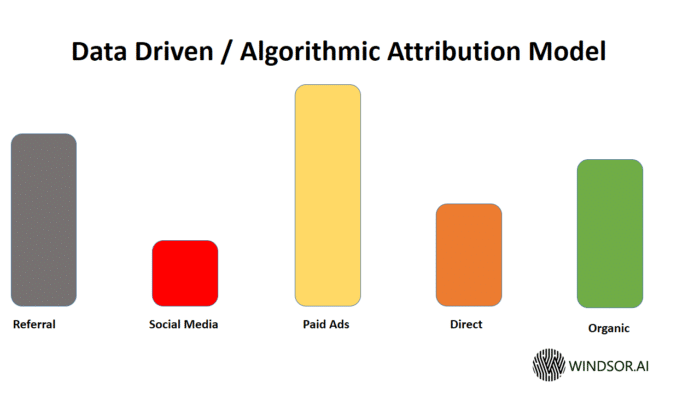
11. Custom, Algorithmic, or Data-Driven Attribution Model
Custom, Algorithmic, or Data-Driven attribution model performs an in-depth analysis of the customer journey. It identifies all marketing channels playing a significant role in bringing visitors to your website and converting them into customers.
Compared to other models’ focus on extremes, this model uses algorithms to give each channel the credit it deserves. It helps you better evaluate the performance of each click and interaction.
Example:
There is no defined process for the data-driven attribution model as it varies from organizations to the marketing processes.
It means you don’t have to choose but create a model that fits your needs.
For this, you need to review your past marketing performances, identify your end goals, and evaluate each channel on par with effectiveness in accomplishing those goals.
When to use and to avoid custom attribution model
Ideally, every business should use a data-driven attribution model as it gives the most credit to your best channels and eliminates underperforming ones.
But to have a data-driven attribution model, you need the help of a pro data scientist and crunchers at your hand. If you have the resources, budget, and time to create a data-driven attribution model, you should ditch all other attribution models against it.
And similarly, avoid a data-driven attribution model, when you can’t bear the burden.
Summary
Each marketing attribution model solves its purpose. While the custom model gives the most advanced insights, it’s not always the best solution to spend recourses on building it. Start with a clear goal, define your channels, and then choose one of the models that fit your case.
